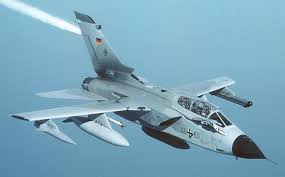
Developed from the Tornado IDS for a wholly RAF requirement, the Tornado ADV (Air Defense Variant) is optimized for long-range interception. Key features comprised installation of Foxhunter radar and a lengthened fuselage for carriage of semi-recessed Sky Flash air-to-air missiles. The interim F.Mk 2 was soon replaced by the definitive F.Mk 3. The RAF received its first of 152 production F.Mk 3s in 1986 and these have since had several updates. The Stage 1 upgrade included hands on throttle and stick controls, radar absorbent material coating, and flare dispensers while Stage 2 enhances the computer and radar imagery and adds the joint tactical information data-link.
The long-awaited Eurofighter Typhoon is intended first to replace the F.Mk 3, but as an interim measure, the RAF is further upgrading 100 F.Mk 3s trough a Capability Sustainment Programme (CSP). This adds AMRAAM and ASRAAM capability (albeit not exploiting the full potential of these weapons via digital avionics and helmet-mounted sights), a multiple target engagement capability for the radar and improved defensive aids. The Common Operational Value (COV) modification features some structural reworking, and night vision goggles-compatible cockpit with new displays, GPS and Have Quick secure radios. The first CSP/COV aircraft were re-delivered to RAF units in 2000. The RAF's F.Mk 3 force of five frontline units, plus an OCU, is based at Coningsby, Leuchars and Leeming.
Saudi Arabia received 24 new F.Mk s while Italy leased 24 upgraded, ex-RAF F.Mk 3s from 1995 as interim fighters, pending arrival of its Eurofighter Typhoons. ADVs have seen combat with all three nations, during Desert Storm, over the former Yugoslavia and in other NATO peacekeeping actions.
The arrival of operational Eurofighters for the RAF in 2005 released surplus Tornado F.Mk 3s for a variety of combat support roles. Although the airframes are likely to require a further structural re-work, they could be re-equipped with radar targeting avionics and ALARM anti-radar weapons to address a clear short-fall in NATO's defense suppression capability.





 მთავარი გვერდი
მთავარი გვერდი თამაშები
თამაშები



